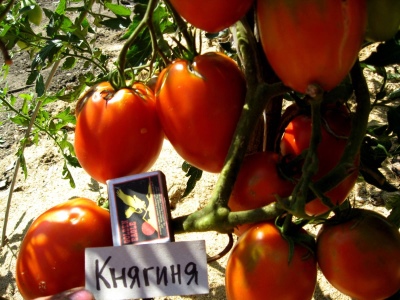
- Authors: Dederko V.N., Postnikova O.V.
- Year of approval: 2006
- Category: grade
- Growth type: indeterminate
- Appointment: universal
- Ripening period: mid-season
- Ripening time, days: 100-105
- Growing conditions: for open ground, for film greenhouses
- Marketability: high
- Bush size: tall
The Princess tomato has been used for quite some time so that clear and unambiguous conclusions can be drawn about it. Therefore, this culture deserves a lot of attention and can be used by gardeners relatively freely. However, success can only be achieved by those farmers who carefully study its main features.
Breeding history
Domestic gardeners can grow the Princess thanks to well-known breeders - Postnikova and Dederko. The crop was approved for public cultivation in 2006. The planting material is distributed by the Siberian Garden company.
Description of the variety
In all the beds, the "feudal mistress" grows according to an indeterminate pattern. The culture is characterized by versatility and decent harvest quality. There is also no need to complain about its small volume. The Princess's bushes rise 1.8-2 m above the ground. They are covered with large dark green foliage.
The main qualities of the fruit
When the berries have just emerged from the ovaries, they will have a green color. In the area of the peduncle, an expressive dark green spot is noted. Mature specimens are red in color. On average, the harvest will weigh 287 g. The shape of a cylinder is typical for the Princess's fruits, and from 4 to 9 berries develop on the clusters. The main stem gives up to 9 clusters, covered with simple inflorescences and articulated peduncles.
Taste characteristics
The Princess tomato is distinguished by its expressive sweetness. This culture forms a fairly dense flesh. Farmers note that this pulp is fleshy. It has a rich taste.
Ripening and fruiting
Full ripeness of berries is achieved in 100-105 days. Their count begins from the moment the green shoots form. If the plant has already begun to bear fruit, it will do so for a very long time.
Yield
The variety belongs to the high-yielding varieties. The collection is 13.3 kg per 1 m2. It will be possible to remove up to 20 pieces of tomatoes on 1 bush.
The timing of planting seedlings and planting in the ground
It is necessary to prepare seedlings (plant seeds) 55-60 days before the expected date of transplantation in open ground. Such a date is assigned individually everywhere, taking into account the characteristics of the region and the actual weather. The factual readiness of plants also plays an important role. Important: before planting, the characteristics of the seeds should be assessed and selected by a water test. The normal development of seedlings is ensured only if there is good illumination.

Growing tomato seedlings is an extremely important process, because it largely depends on whether the gardener can harvest at all. All aspects must be taken into account, from seedbed preparation to planting in the ground.
Landing scheme
For 1 sq. m it is recommended to plant no more than 3 bushes. The distance between them must be at least 50 cm.The garter stakes are placed in the ground immediately after transferring the plants to the open ground.

Growing and caring
Care measures for such tomatoes are well established. It has been established that they need both a garter, and formation, and the elimination of excess stepsons. For normal development, the Princess needs fertile land. But it is hardly possible to be limited to them alone - you will almost always have to use additional feeding. In the southern regions, this variety can be cultivated even outdoors.
But in the middle lane and more northern areas, it is grown only in greenhouses. Departure from this rule only threatens the emergence of serious problems. In addition to the garter, timely watering is very important for the Princess tomatoes. For the first time, they are watered abundantly immediately after planting. In the future, irrigation is usually carried out every 7-10 days. At the same time, the air temperature and the degree of soil drying are taken into account.
Loosening of the soil is carried out every 10-12 days. This is important even without being confined to watering and precipitation. You will have to get rid of excess stepchildren weekly. In addition to natural dressings, it is quite possible to use "Fundazol". Foliar dressing is just as important as root fertilization.




A plant needs different micronutrients at each stage of growth. All fertilizers can be divided into two groups: mineral and organic. Folk remedies are often used: iodine, yeast, bird droppings, eggshells.
It is important to observe the rate and period of feeding. This also applies to folk remedies and organic fertilizers.



























































































